Yoga
“Yoga teaches us to cure what need not be endured and endure what cannot be cured.” ~B.K.S. Iyengar
“If you want to use yoga to heal emotional pain, you must find out where it resides in your body and learn to take your breath there. I don’t teach yoga to help people to transcend. I want people’s spirits to reside in their body. I literally want to help people embody their spirit. Not go through life fragmented.” ~Ana Forrest
“Yoga cultivates your witness consciousness. It allows you to observe yourself on the mat. You aren’t numbing out or going into default mode by overworking, watching TV, or reaching for the alcohol or carbs. For a trauma survivor, yoga, when practiced with awareness of breath and sensation, can be a gentle way to begin to reoccupy her body. When living in a body feels safe again, yoga postures can be used therapeutically to hold and then release the trauma stored there. Often the emotional and physical releases happen without reference to the story, so the survivor is no longer trapped in the victim role.” ~Amy Weintraub
The Theory
“A living organism is a vast sea of energy and information that flows through the myofascial system as a hologram. It is dynamic and fluid with all components, always in instant and continuous communication. ... Repeated postural and traumatic insults of a lifetime, combined with the tensions of emotional and psychological origin, result in tense, contracted and painful fibrous tissue.” (John F Barnes, P.T., L.M.T.)
The effects of trauma are primarily physiological — leaving an indelible biological imprint. Trauma can cause inflammatory response which leads to increased fibrosis; loss of available movement between layers; and stickiness to interstitial elements resulting in chronic conditions of structural abnormality. Trauma disrupts clients’ relationships to their bodies and emotions, leaving them feeling constricted, tense, helpless, disconnected, hurt, agitated, frantic, and in conflict with themselves, others and the world.
By now, there can be little doubt that one’s state of mind and one’s body are intimately related. When the mind is relaxed, the muscles relax. When stressed, a state of physical and mental tension is produced.
"All systems of the body exchange neuropeptide information, and it is the internal feeling state (emotions) that elicits the neuropeptide response. This is the mind-body connection in which every change in the mental-emotional state causes a change in the body physiology. Likewise, every change in the body physiology causes a change in the mental-emotional state." (Pert, 1997)
Addressing the body’s deep sensations and emotions, Hatha Yoga facilitates clients in; addressing their autonomic nervous system symptoms of hyperarousal; processing their traumatic memories; promoting mastery over the posttraumatic legacy of self-doubt and despair; appreciably changing how they organize themselves in relation to the world; and aiding in the reclamation of autonomy and authority over their own lives.
The Trauma Center at Justice Resource Institute (JRI) in Massachusetts has conducted preliminary research investigating Hatha Yoga’s effect on some common symptomatology of PTSD. The research bears out yoga’s efficacy on core physiology associated with PTSD including Heart Rate Variability (HRV). Although there are different types of yoga, most Westerners already identify yoga with Hatha Yoga — a yoga that seeks to promote health and well-being through physical exercise. With its profound effect on the circulation and on the functioning of the inner organs, glands, and nerves, a regular practice of asanas (postures), and breathing exercises (pranayama) makes the physical body strong, supple, and healthy. In addition, yoga offers psychological and spiritual benefits as well.
Yoga for PTSD
An essential aspect of recovering from trauma is learning ways to calm down, or self-regulate. For thousands of years, Yoga has been offered as a practice that helps one calm the mind and body. More recently, research has shown that Yoga practices, including meditation, relaxation, and physical postures, can reduce autonomic sympathetic activation, muscle tension, and blood pressure, improve neuroendocrine and hormonal activity, decrease physical symptoms and emotional distress, and increase quality of life. For these reasons, Yoga is a promising treatment or adjunctive therapy for addressing the cognitive, emotional, and physiological symptoms associated with trauma, and PTSD specifically.
Yoga is recognized as a form of mind-body medicine. The relaxation induced by meditation helps to stabilize the autonomic nervous system with a tendency towards either sympathetic or parasympathetic dominance. Because yoga decreases the amount of catecholamines produced by the adrenal glands during stress, yoga offers a host of psychological benefits. By lowering the hormone levels of the neurotransmitters norepinephrine and epinephrine, yoga produces an increased feeling of calm and well-being. Additionally, by boosting oxygen levels to the brain, yoga is likely to reduce anxiety and depression.
Spiritually, a yoga practice can counter the sense of isolation often experienced by trauma clients, offering, instead a sense of connection to the Divine Being or a feeling of transcendence. Yoga is the one single technique that combines and provides the benefits of breathing exercises, stretching, fitness programs and meditation. Because it is a system for restoring balance to the body, mind and spirit, Yoga is an ideal modality for trauma clients. By working with the body and the breath in a series of postures (asanas), yoga enables them to release muscle tension, gain flexibility and strength, and quiet the mind. Additionally, yoga practitioners become more resilient to stressful conditions and reduce a variety of important risk factors for various diseases, especially cardio-respiratory diseases.
The Tools
Below are some examples of posture (asana) groups with some basic instruction. Feel free to experiment, but like most things, one size does not fit all. A yoga practice should be individualized for each person. Although it’s true that every posture (asana) may not be right for every person, there seem to be some that are particularly useful to most people.
Yoga should NOT be painful

Restorative Postures are poses that aim to soothe the nervous system and release muscle tension. Examples include: Easy Pose and Corpse Pose.
Sitting/Easy Pose (Sukhasana) is a simple sitting pose.
This is a good starting position that will help to focus your awareness on to your breath and body, while strengthening your lower back and opening both the groin and hips.
1. Sit cross-legged with hands resting gently on your knees. (variation: sitting back your heels, with hands resting on your thighs)
2. Focus on your breath-how ever it is and how ever it changes.
3. Keep your spine straight, while gently pushing your sit bones down into the floor.
4. Allow your knees to gently lower toward the floor.
5. If your knees rise above your hips, sit on a cushion or block to help support your back and hips.
6. Take a few slow, deep breaths.
7. Now with the next inhale, gently raise your arms over your head.
8. Exhale while bringing your arms down slowly.
9. Repeat a few times.
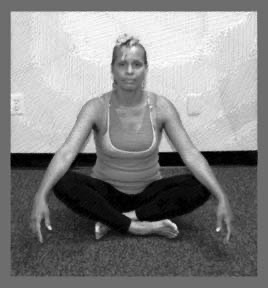
Variation
Variation
As with any pose, if you find it difficult or painful, feel free to try different variation(s). In this case, it’s the half lotus posture. Instead of placing both feet on the thighs, only one foot is placed on top of the opposite thigh and the other is place under the opposite thigh. Feel free to alternate positions to allow both knees to be stretched.
Yoga should NOT be painful

Seated Neck Rolls
1. Begin by sitting in easy pose (Sukhasana)
2. Slowly allow your chin to sag gently toward your chest.
3. On the inhale, roll your left ear toward your left shoulder. On the exhale, come back to center.
4. On the inhale, roll your right ear toward your right shoulder. On the exhale, come back to center.
5. Continue to slowly rolling your head from side to side for a few breaths, noticing any sensation that arise, including any tension, tightness, soreness, numbness that may be there.
6. Notice your neck muscles as they contract and relax with the movement. Experiment with bigger or smaller movements, paying attention.
7. When you are ready, gently guide your chin back to center, lifting your head up and back to center.
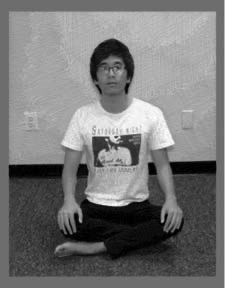
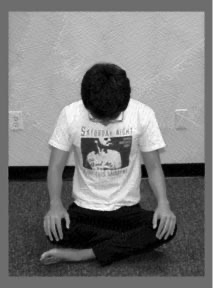

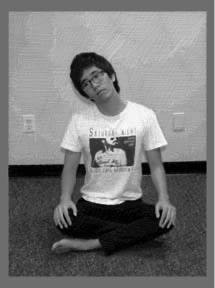
Corpse Pose (Savasana) is a resting pose (a fully-present, fully-aware resting pose) that provides the body the time necessary to process and integrate information at the end of the practice.
1. Begin by gently lying down on your back (Fig 1). Breathing deeply in and out through your nose, gently allow your feet to fall out to either side.
2. Slightly separate your arms from your body-allowing them to rest comfortably alongside your body, with your palms facing up (Fig 2). If that doesn’t feel comfortable to you, you might try placing your arms across your chest or lying on your side (Fig 3).
3. If you like, allow your eyes to close.
4. Begin to bring your awareness to your breath. Allowing it to be natural-that is, how ever it is, and how ever it changes.
5. Let the body feel heavy as you become aware of your body resting on the floor. You may wish to set an alarm for this (from a minute to several minutes)
6. After the set period, you should begin to come out of the pose, by first beginning to the deepen your breath.
7. Take a few deep breaths, as you begin to move the fingers and toes, reawakening the body.
8. When you feel ready, bring your knees into your chest and roll over to one side, slowly bringing yourself back up into a sitting position.
9. While sitting in this way, become aware of any sensations that arise.
Fig 1
Fig 2
Fig 3
Standing Mountain Pose is helpful for grounding and centering the body and calming emotions.
1. Begin by standing with your feet shoulder width apart, taking notice of your feet placed firmly on the ground.
2. Rest your attention on your feet, while observing anything that comes into your awareness.
3. When you are ready, begin to slowly roll your weight onto your toes... and then come back down again. Observe any sensations. ...paying particular attention to the connection that they make with the ground.
4. With your feet firmly planted on the ground, shift your awareness to the top of your head.
5. Taking a slow, deep breath, begin lifting up through your core to the top of your head. Notice this feeling, ...this feeling of being firmly rooted to the ground, while extending your body toward the sky. Notice any sensations or emotions that accompany this standing position.
6. Now, with your feet planted firmly under your extended body, bring your attention to the area just below your navel.
7. Rest your awareness here. your center of gravity. your core.
8. Remain here for a moment, noticing your center.
9. Observe any sensations or emotions that accompany this position.
10. As you inhale, imagine the breath coming up through the floor, rising through your legs and torso and up into your head.
11. Reverse the process on the exhale and watch your breath as it moves down from your head, through your chest and stomach, legs and feet.
12. Hold this standing tall posture for 5 to 10 breaths.
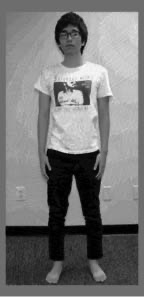
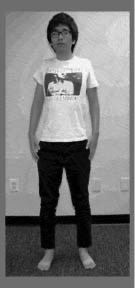
Forward Bend is a tension-releasing pose for the back, spine, shoulders and upper body area – for increasing the flow of prana or vital life force.
1. Begin by standing upright (see posture above, Standing Mountain Pose)
2. Place your hands on your hips.
3. Take a breath in, bend your knees slightly, and on the exhale, gently bend forward from the hip joints, not from the waist.
4. Allowing your hands to be dangle freely in front of you, as you gently reach toward the floor.
(If touching the floor isn't possible, you may want to cross your forearms and holding opposite elbows Fig 2).
5. Now, press your heels firmly into the floor and lift the sitting bones toward the ceiling. Turn the top of your thighs slightly inward.
6. Notice any sensations that accompany this folded over in this position. Notice where your weight is, and what happens when you shift slightly to the left, right, front or back.
7. With each inhale, lift and lengthen the front torso just slightly; with each exhale, release a little more fully into the bend, allowing your torso to oscillate with the breath.
8. Let your head hang from the root of the neck, which is deep in the upper back, between the shoulder blades. If you like, begin to move your head slightly from side to side and/or up and down, while taking notice of any sensations or emotions that arise.
9. When you are ready (or after a minute or so), gently and slowly begin to roll your spine up, once again coming into a standing position (mountain pose).
10. If you notice any tension/tightness or discomfort in your low back, place your hands on your thighs supporting yourself as you ascend.
11. Once back in mountain pose, allow your breath to return to “normal” while paying attention to how your body feels in this position
Fig 1
Fig 2
Yoga should NOT be painful

Child’s Pose (Balasana) is a resting pose.
1. Begin by coming down onto the floor into a kneeling position. Touch your big toes together and sit back on your heels.
2. Spread your knees about as wide as your hips and lay your torso down between your thighs.
3. Gently stretching, lengthen your tailbone away from the back of the pelvis, while lifting the base of your skull away from the back of your neck.
4. Lay your hands on the floor alongside your torso, palms up, while releasing the fronts of your shoulders toward the floor.
5. Feel how the weight of the front shoulders pulls the shoulder blades wide across your back.
6. Remain in this pose anywhere from 30 seconds to a few minutes.
7. When you are ready to come up, first lengthen the front of your torso
8. Take a slow deep breath as you lift from the tailbone as it presses down and into the pelvis.
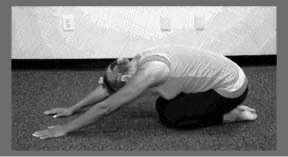
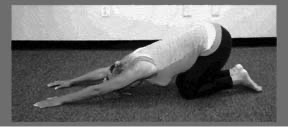
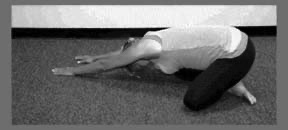
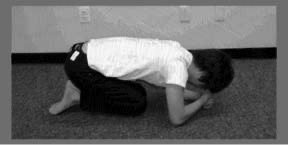
Yoga should NOT be painful

The Research
Yoga for depression: the research evidence. Pilkington K, Kirkwood G, Rampes H, Richardson J.
Uebelacker LA, Epstein-Lubow G, Gaudiano BA, Tremont G, Battle CL, Miller IW.
An eight-week yoga intervention is associated with improvements in pain, psychological functioning and mindfulness, and changes in cortisol levels in women with fibromyalgia Authors: Curtis K, Osadchuk A, Katz J Published Date July 2011 Volume 2011:4 Pages 189 - 201
Effects of Hatha yoga and African dance on perceived stress, affect, and salivary cortisol. West J, Otte C, Geher K, Johnson J, Mohr DC.
External Websites
The International Association of Yoga Therapists
